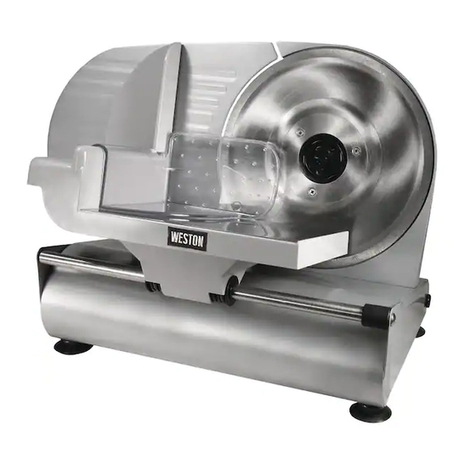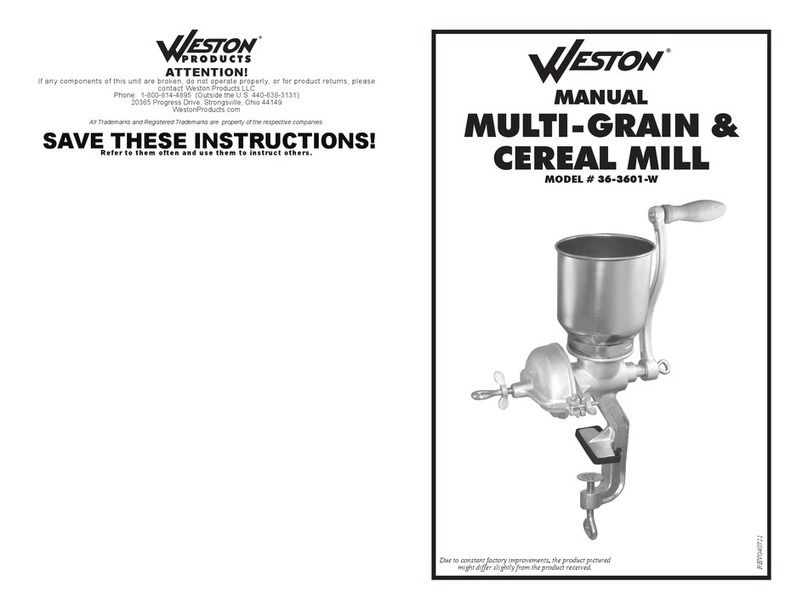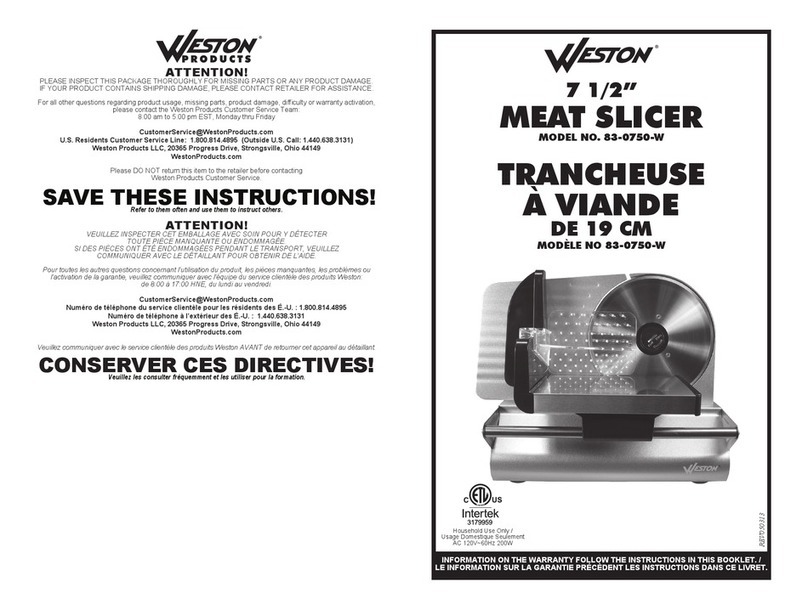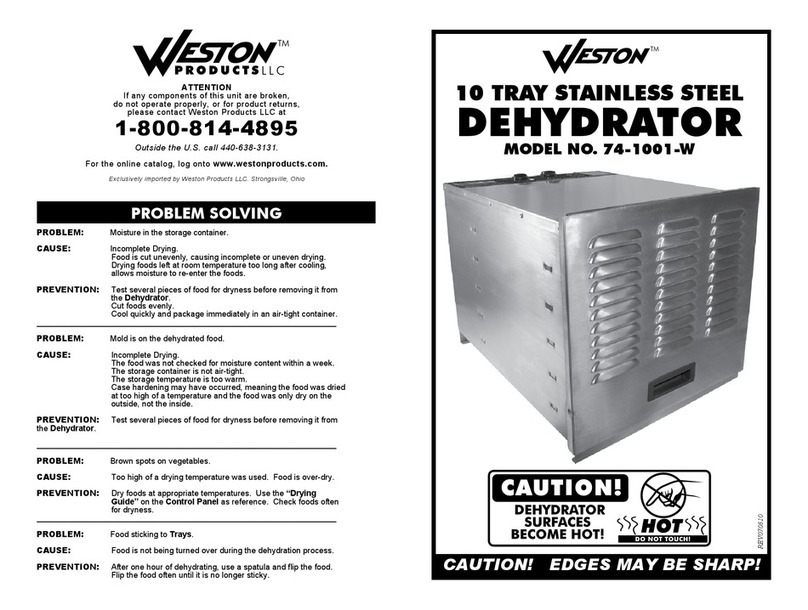BEFORE YOU START BAG SEALING
Before using the Vacuum Sealer, familiarize yourself with the bag sealing functions.
A vacuum bag is sealed when the Seal Bar Heating Element is activated and heats
the bag to its melting point, which then permanently welds the bag layers together,
sealing the bag shut. NOTE: THIS BAG SEALER IS INTENDED TO BE USED
ONLY WITH VACUUM BAGS. FOR BEST RESULTS USE ONLY VACUUM
BAGS. DO NOT USE HOUSEHOLD BAGS!
The Seal Bar Heating Element of the Vacuum Sealer is covered with a high
temperature resistant Seal Bar Tape. DO NOT TOUCH the Seal Bar Tape or the
Seal Bar Heating Element after a bag has been sealed.
WARNING! Before cleaning, assembling or disassembling the
Vacuum Sealer, make sure the Vacuum Sealer is OFF and the PLUG IS
REMOVED FROM THE OUTLET/POWER SOURCE!
NOTE: The Vacuum Sealer is ONLY intended to be used with VACUUM BAGS. For
best results, only use the recommended vacuum bags with an embossed or mesh lining.
DO NOT USE HOUSEHOLD BAGS! Any other uses of the Vacuum Sealer, other
than the uses described in this booklet, could potentially damage the appliance and void
the warranty!
VACUUM SEALER CANISTERS (Sold Separately)
Vacuum canisters may be used
with the Vacuum Sealer (Sold
Separately). Vacuum canisters
come with their own hose.
1. Attach the Vacuum Sealer to
the power supply.
2. Insert one end of the accessory
hose into the Accessory Port
(Figure 4) on the Vacuum Sealer.
3. Insert the other end of the
accessory hose into the port on
the lid of the canister (Figure 4).
4. Fill the canister with the product to be vacuum sealed.
5. Turn the knob/dial on the canister to the seal position.
6. Press the VACUUM ONLY Button on the Vacuum Sealer, this will engage the
Vacuum Pump. The light on the Vacuum Sealer will change to green when the process is
complete.
7. Gently remove the accessory hose from both the canister and the Vacuum Sealer.
Wait at least 20 seconds before vacuuming another canister to avoid overheating the unit.
Be careful not to turn the knob/dial of the canister to the open position.
8. To test vacuum, gently tug on the canister lid. The lid should not move.
9. To release the vacuum and open the canister, turn the knob/dial on the canister to
the open position.
Accessory Port
Accessory Hose
Sold Separately
Accessory Canister
Sold Separately
Figure 4
-8- -13-
. IMPORTANT NOTE: Vacuum packaging is NOT a substitute for refrigeration.
Vacuum packed perishable foods still require refrigeration.
. NEVER thaw frozen foods at room temperature. Thaw frozen foods in a refrigerator
or microwave oven.
. In general, the colder the temperature at which foods are stored, the longer the
shelf life.
. Handle vacuum sealer bags with care. Avoid damaging them. A damaged bag
will not hold a seal.
. Only use information in the following chart as a guideline! Refer to the “Vacuum
Packaging Guidelines” and “Food Safety” sections of this manual. Actual storage life
spans may vary. Check all food for spoilage before use.
STORAGE LIFESPAN GUIDELINES
FOOD STORAGE NORMAL VACUUM
TYPE LOCATION LIFE PACKED
LIFE
LARGE CUTS OF MEAT Freezer 6 months 2-3 years
GROUND MEAT Freezer 4 months 1 year
FISH Freezer 6 months 2 years
For best results, freeze meats & sh for 1-2 hours before vacuum packing to help prevent moisture
and juices from interfering with the seal of the vacuum bag.
COFFEE BEANS Room temperature 4 weeks 16 months
COFFEE BEANS Freezer 6-9 months 2-3 years
FLOUR, RICE, SUGAR Room Temperature 6 months 1-2 years
For best results, powder or grainy substances should be kept in their original container or bag, then placed in a
vacuum bag for sealing to prevent interfering with the seal of the vacuum bag.
BERRIES strawberries, raspberries, blackberries Refrigerator 1-3 days 1 week
BERRIES cranberries, huckleberries, blueberries Refrigerator 3-6 days 2 weeks
To prevent berries from being crushed by the vacuum sealer, it is best to freeze item before packing. Spread the berries out on a
cookie sheet to allow them to freeze individually. Berries frozen in a large block will be difcult to vacuum seal due to the
many small air pockets that would form between the berries.
CHEESE Refrigerator 1-2 weeks 4-8 months
If vacuum packed cheese is used often, make sure the vacuum bag is long enough to allow for repeated sealing. For shredded
cheese, place a paper towel inside the vacuum bag, on top of the cheese to prevent the cheese from being
sucked into the Vacuum Sealer or interfering with the sealing of the bag.
COOKIES, CRACKERS, BREADS with periodical opening Room Temperature 1-2 weeks 3-6 weeks
Freeze soft airy foods for 1-2 hours prior vacuum packing, to retain shape & texture.
PASTA, GRAINS, DRIED BEANS Room Temperature 6 months 1-1/2 years
NUTS Room Temperature 6 months 2 years
Dried foods with sharp edges should be wrapped in a paper towel or other matter to prevent the sharp edges from puncturing the vacuum bag.
LETTUCE Refrigerator 3-6 days 2 weeks
Wash & thoroughly dry leafy vegetables before vacuum packaging.
VEGETABLES Freezer 8 months 2 1/2 years
To maximize the taste of vegetables, blanch them before vacuum packaging. Blanching cooks the vegetables very briey, sealing
in the avor, color and texture, leaving the vegetables cooked but still crisp. Vegetables can be blanched in boiling water in the microwave,
most vegetables only require 2-3 minutes (corn on the cob requires 6-11 minutes). Then immerse the vegetables in cold water to
stop the cooking process. Dry the vegetables, then vacuum pack.
Table adapted from Dr. G.K.York, Dept. of Food Science & Tech, U of California, Davis.

































